
|
| To tell the truth, if we had
stuck to our original plans and not bought more plants for the back
yard every time we got within a mile of a nursery, we might never
have got around to reworking our front yard. Despite the fact that
it was one of the first things we thought of doing when we moved
in four years ago, it was really our backyard jungle which kicked
us out of of our inertia. That, and the fact that our shade trees
had grown phenomenally well, and our sun loving perennials were
not amused!
|
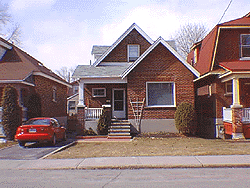
|
|
Why a "streetscape", rather than the traditional lawn, tree and foundation plantings? It strikes me the North American front yard traditions stem from the pioneer's desire to tame the wild, push back the wilderness - and the more you could demonstrate that "power", the higher the status you demonstrated. However, from inner city to suburban lot, the effect is now to sterilize our visual environment, reduce the planet's natural oxygen generation, and drive out the last remnants of wildlife from our urban centers.
I'm not against grass: I find cutting it relaxing, not a chore! But ecologically and visually it is hard to defend when that's all there is! To help it stay healthy, green, and weed free we use far too many chemicals and far too much water. We have in fact given many weeds the chance to survive and flourish. The dandelion, Ottawa's curse, was originally brought to the continent as an early spring edible leafy green, and forced to compete in a "wild" environment it actually does not do very well. It certainly is not invasive. But when fertilized, and with its main competitor shorn on a weekly basis, weak-stemmed, and susceptible to drought, it can quickly take over and kill a healthy lawn.
|
 |
|
That said, developing a design which fits your needs, desires - and your house! - remains open to a broad number of solutions. In our case, we had no large trees and did not want to create more shade by planting one. Secondly, the lots are very narrow in our area (30 feet), and for the most part grass and lawns. We did not want to emphasize the narrowness, nor stand out as a rectangle of exception! We did not want to rip out any of the hardscape that existed, and as much as possible we wanted to use the plant material at hand. This was to be a low-cost project!
|
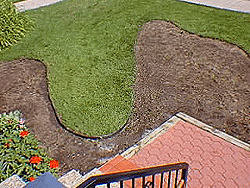 |
While the initial ideas we had included paving stone or crushed brick paths, some raised beds and perhaps a very small tree planted
to the north side, these were thrown out either for cost or because
the house and the lot were not open to such an approach. Sunny
perennial beds, integrating the plan into neighboring lawns, but
giving the yard a three-dimensional feel became the overriding
objectives. Finally, after talking ourselves into exhaustion,
and two hours before sunset one evening, we pulled out the garden
hose and a can of latex spray paint, and kicked, nudged and tugged
our way into a final design. As the light level fell, we spray-painted
theory into fact! The next day, the neighbors thought we had been
bizzarely vandalized!
|
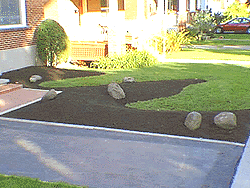
|
|
We smiled, rented a rototiller, and began ripping up the front
lawn. Neatly, mind you! (We rototilled because the 50 year old
lawn needed the stirring up, and allowed us to bury some of the
sod, while composting the rest). We did install plastic edging
to slow down the intermingling of the two. I'm not fond of it
visually, so I always bury it deeper than recommended, where it
gets hidden by the grass, plants and mulch, but still remains
an effective barrier to block the grass roots. The design allowed
us to use the existing lawn as "paths", and blended into our neighbor's
lawn, visually expanding the apparent size of the lot. The planting
beds total approximately 750 square feet, running 20 feet up the
driveway and (in some aspects) 20 feet across the front of the
house)
|

|
|
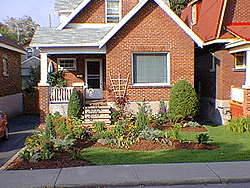
|
|
Next came 3 cubic yards of compost-enriched top soil, and a careful
sculpting of the two-dimensional form we had worked out. We wanted
a 'natural' appearance and settled on a long curving, and undulating
wave pattern, lowest at lawn level and highest against the hardscape
of house, walk, and driveway. Pictures (bottom left) capture the
berms just completed, and then the large rocks dumped into approximate
final locations. A third photo details the effect of partially
burying large rocks in to the ground, in effect "naturalizing"
them. It is the approach I prefer for introducing a few accent
rocks into the landscape. They should be "planted" with as much
care as the plant material itself.
|
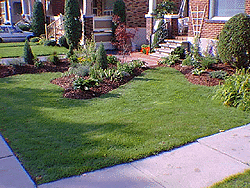
|
The next step was the planting of the major shrubs and evergreens. In northern climates, this is especially important to view as a separate activity - they provide not only the backbone of the garden design, but in early spring, late fall and all winter long the only visual evidence a garden exists. For the evergreens we chose mostly dwarf varieties so the house would not be overwhelmed, and always varieties which are receptive to heavy pruning. Our intention is to keep them, by their nature or ours, fairly small specimens. Our "tree" ended up being a Japanese maple, which at six feet, is close to its mature size. In total, we only purchased 12 new plants - which, honestly, is very good - for us!
|
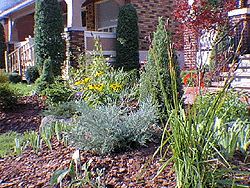
|
Then we set out to canabalize the back yard! I am forever amazed by process of division. You plant a tiny perennial, and three years later divide it into four, ending up with each clump three times the size of the original. To avoid having too many of one variety, we began trading around the neighborhood, and with other gardening friends in the region. It is, without a doubt more strenuous and time-consuming than a quick trip to the nursery - however, the plantings you end up with are giants compared to the affordable nursery-grown versions, and importantly, are excellent, tried and tested hardy examples of their species. After all, if they have survived for five or ten years in your neighbor's garden, they certainly should in yours!
|
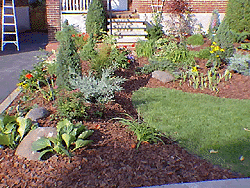
|
|
The final step was to lay down a thick layer of mulch - in our
case "mini-nuggets" of red cedar bark, which retains its brick-red
colour fairly well and is very slow to decompose. Our front yard
is very sunny and airy, and tends to dry out excessively in the
hot summer months. And given the steepness of the berms we thought
it was crucial to catch both rain and any sprinkler watering that
may be required. And importantly, it visually integrated the new
beds with the existing brick of the path and house. A few neighbors
warned us the earwigs love the environment, but since the garden
seems to have immediately become a favorite area for birds and
other wildlife - we're hoping we won't have to publish a whining
postscript to this article next fall! At any rate we have had
considerable success with most of our annoying insect population
by over planting so much you don't really notice the amount of
vegetation which is actually eaten!
|
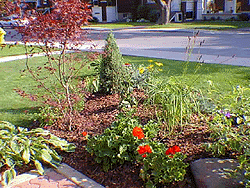
|
We're delighted with how our new streetscape has worked out. Using predominantly large-sized plant divisions and transplants from our back yard and neighbors gave us a garden that looked three years old the day we finished. We do tend to use the front of the house much more than we had previously, and the house feels like it's set in a garden, rather than just having a garden in the back. And - the unexpected reward - it gave us a whole new project to think about. That driveway stretching to the back of the house may keep the water out of the basement, but it does break the flow between front and back gardens!
|
|

